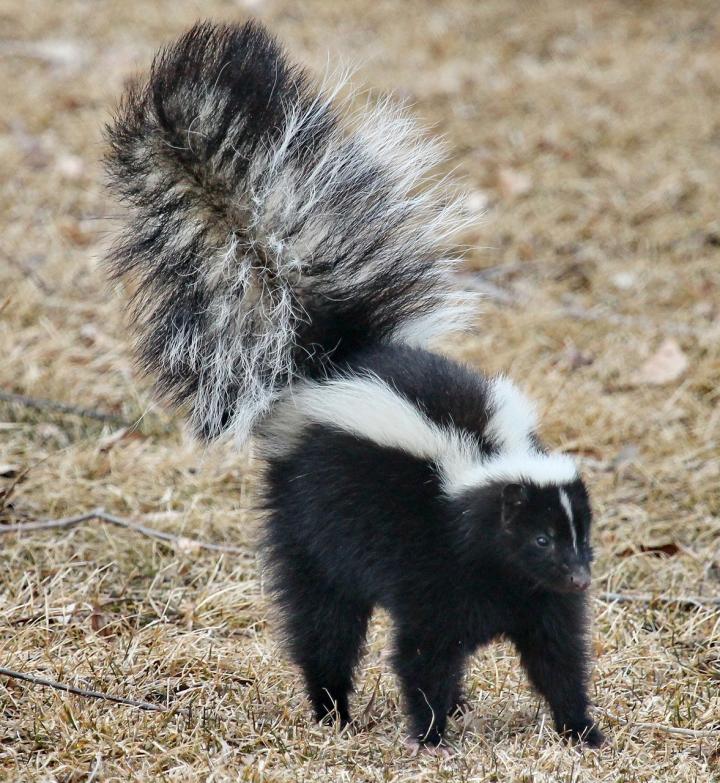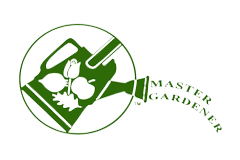Claudette Sims – Halton Master Gardener
Outdoor gardening season in spring brings renewed questions from Ontario gardeners struggling with various animal pests in gardens. Integrated Pest Management (IPM) is the best approach. This is an ecosystem-based strategy that focuses on long-term prevention of all pests (including weeds) or their damage through a combination of techniques. It begins by assessing the risk posed by the pest and determining if any action is really required-there is a threshold for action. If the threshold is met, an effective pest management program uses the best combination of five basic treatments:
- Cultural
- Mechanical and physical
- Biological
- Behavioural
- Chemical (repellents & poisons)
Before taking any action, consider the following:

- Chipmunks, squirrels and raccoons, while they can do structural damage and eat your plants, they also consume quantities of invasive gypsy moth pupae. Chipmunks even favour the female pupae of gypsy moths. Gypsy moth larvae are a well-known pest which eats the foliage of trees in spring. Chipmunks also eat baby mice and may be essential to keep rodent populations in check.
- Skunks are shy creatures that can’t climb. Barriers along the fence line may be all that is needed.
- Opossum, while a bit scary looking, are very gentle, harmless creatures and very beneficial as they eat enormous amounts of ticks.
- Snakes are very beneficial in the garden and help to control the population of pests so it is urged to not only tolerate but encourage their presence. They are very effective against mice and rats.
- Rats are attracted by water and food, including garbage and pet food.
- Most “bugs” such as wasps, spiders, beetles and bees are beneficial and eat other “bugs”.
- Part of the joy of gardening is having the privilege to watch the many living creatures that share our outdoor spaces.
Start by asking questions:
- What is the animal ‘pest’? Does it have a beneficial role to play in my garden?
- What is attracting it to the garden?
- What is its lifecycle and is this going to be a transient problem or a perennial issue? There may be more damage in spring when animals have young to feed.
- Can I live with the damage, or do I need to take further action?
In most cases, living with wildlife and allowing some minimal damage is the appropriate response. If you can’t live with the damage, then consider the following:
- Change cultural Practices
- Reduce attractants: Remove food sources that attract the animal pest. e.g. bird feeders, bread left out for birds, compost, pet food left outside, unsecured garbage. Note: bread should never be left out for birds as it causes health issues such as obesity & malnutrition and is more likely to attract rats.
- Grubs – Voles, skunks and raccoons may be attracted by grubs. Reduce grubs in lawn by changing lawn practices, e.g. interplanting, watering differently, using mulches may be part of the solution. Nematodes can be used to reduce grub populations, but keep in mind that they will kill a number of other insects such as beneficial fireflies whose larvae eat snails and slugs!
- Plant selection – Choose plants that are repellents (garlic) or simply not attractive to the pest.
- Chipmunk damage – Try providing a water supply in the garden that chipmunks can access, as anecdotal evidence suggests they may actually looking for a water source, when they nibble on your tomatoes.
- Pull mulch –away from trees & ornamentals to deter voles from chewing.
- Seal off foundations – and the area under decks with skirting or heavy mesh or bricks to prevent skunks, raccoons from digging and making a den under buildings or porches.
- Garbage – use containers with lids that lock. Don’t place outside until garbage day.
- . Mechanical or Physical Practices

- Barriers can be an effective long term solution for a recurring animal pest problems, e.g. fences, root barriers, screens, coarse mulches.
- Create cylinders around plants such as tomatoes using galvanized steel mesh. It’s quite rigid and holes are small enough to deter chipmunks.
- Protect plants with black bird mesh sold at nurseries. Both bird mesh and steel mesh appear less visible than regular chicken wire and are generally more tidy-looking. Be aware that bird mesh can trap other beneficial creatures such as snakes. Inspect regularly.
- Care should be taken to bury some of the fencing and restrict access from the top, since chipmunks are able to both burrow and climb.
- Cylinders of heavy wire hardware cloth will protect valuable young trees from rabbits.
- Cats – can be deterred from using your garden as a litter box by placing “prickly” plant cuttings in the problem area e.g. prunings from roses, juniper. There is anecdotal evidence that coffee grounds heavily sprinkled in an area will also deter them.
- Relocation – In Ontario, in some locations, certain types of wildlife can be physically relocated if they are damaging property. Check your community bylaws and protected status of the animal in question, e.g. Eastern Least Chipmunks are specially protected mammals.

- Biological Controls
- Invite beneficial predators and parasites into your garden, by creating refuges for predators, e.g. snakes and birds to control rodents, coyotes & foxes to reduce squirrel & rabbit populations.
- Note that shifting species prevalence can have unintended consequences and should be approached cautiously.
- Behavioral Remedies
- Scare techniques can deter mammals from coming to your garden, e.g. scarecrows, noise makers, motion triggered light or water spray.
- ScarecrowTM sprays a jet of water activated by motion sensors and can deter chipmunks & deer but may not be as effective with other animals such as raccoons. Place these where animals enter the garden area and move them frequently.
- Borrowing a dog can be effective o Snakes: There is anecdotal evidence that plastic snakes will deter certain animals like squirrels and chipmunks. Move them around often.
- Chemical (Repellents and Poisons ) – SEE NOTE Re Cayenne Pepper/Capsaicin Below
- Repellents need to be kept fresh for maximum effectiveness.
- The two kinds of repellents are CONTACT and AREA. Contact repellents are applied directly to the plants and repel by taste. Area repellents are applied near the plants and repel deer by smell alone. There are several brands of animal repellents to choose from that are helpful in deterring deer. Not all can be used around vegetable gardens. Some of the commercially available repellents are:
- Bonide Rabbit-Deer RepellentTM – It produces a very bad taste. Can be sprayed or brushed onto plants.
- HinderTM – A soap-based product that repels by odour. It needs to be reapplied after heavy rain.
- Ro-PelTM – This has both odour and taste repellent properties. Spray it on both sides of the leaves of landscape plants.
- PlantskyddTM – This is effective for up to six months for controlling deer, rabbits, voles and other small animals and does not to be reapplied after watering or rain.
- BobbexTM – All natural deer and rabbit repellent and will also deter small animals. Can be used as a bulb-dip to prevent underground damage after planting.
- Note: Soiled cat litter sprinkled around the edge of flower garden may be a deterrent but is not recommended near food plants and is likely to attract unwanted cats.
- Pelleted Hen manure has been found effective sprinkled on the soil where bulbs are planted.
- Poisons – Keep in mind that poisoned bait will result in poisoned carcasses which can poison the desirable predators and possibly pets as well.
USE OF CAYENNE PEPPER (CAPSAICIN PRODUCTS)
There are serious concerns about the use of cayenne pepper to deter animals. Recommendations to use cayenne are met with very strong reactions from our forum members due to concerns about animal cruelty. Cayenne pepper can irritate skin and eyes of creatures (with the exception of birds). It may also impact pollinators, although has not yet been considered a significant risk by permitting authorities (PMRA and EPA). As with most chemical options, it should be chosen only when the damage done exceeds thresholds of concern and when other less harmful options have been fully explored.
Capsaicin is a repellent to mammals at concentrations between 10 and 100 ppm. In Ontario, many products containing capsaicinoids and similar functioning piperine (oil of black pepper) are registered to repel vertebrate pests such as rabbits, squirrels, deer, voles, raccoons, cats, dogs, and skunks. Products registered in Ontario include: Bobbex Deer Repellent, Plantskydd, Chemfree Critter Ridder, Scent-A-Gone Animal Repellent, etc. It should be noted that Capsaicin is also used to inhibit certain invertebrates (e.g. insects, spiders, millipedes) and this may have implications for pollinators.
“Capsaicin is very irritating to the skin and eyes, and it causes swelling in lung tissue. It can also irritate the mucous membranes in the mouth. In insects and mites, it appears to damage membranes in cells and disrupt the nervous system. Most wildlife will avoid capsaicin because it has such a strong odor and taste. However, birds cannot taste capsaicin and will not be repelled by it. Capsaicin is toxic to bees and other beneficial insects. Researchers believe that capsaicin and similar compounds protect the seeds inside the peppers from fungus.” According to Gervais, J. A. ; Luukinen, B.; Buhl, K.; Stone, D. 2008. Capsaicin General Fact Sheet; National Pesticide Information Center, Oregon State University Extension Services. http://npic.orst.edu/factsheets/capgen.html.
The capsaicin lethal dose for Apis mellifera bees is greater than 100 μg per individual (Flesar, J., Havlik, J., Kloucek, P., Rada, V., Titera, D., Bednar, M., and Kokoska, L. (2010). In vitro growth-inhibitory effect of plant-derived extracts and compounds against Paenibacillus larvae and their acute oral toxicity to adult honey bees. Veterinary Microbiololy, 145: 129-133. doi.org/10.1016/j.vetmic.2010.03.018.)
References used by C. Kavassalis: Capsaicin and Related Capsaicinoids (based on the Science Evaluation of this consultation document and Evaluation Report ERC2012-03, Capsaicin: Technical Fact Sheer: National Pesticide Information Center http://npic.orst.edu/factsheets/archive/Capsaicintech.html
EPA R.E.D. Facts for Capsaicin: https://www3.epa.gov/pesticides/chem_search/reg_actions/reregistration/fs_PC-070701_1-Jun92.pdf
References used by C. Sims: Reference Manual for Ontario Master Gardeners

